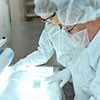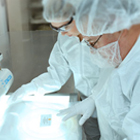Methyl+2-(trifluoromethyl)imidazo[1,2-a]pyridine-6-carboxylate
Lieferant:
Biotium
Beschreibung:
This antibody recognizes a transcription factor of 64-67 kDa, identified as c-myc. This MAb shows no cross-reaction with v-myc. c-myc is involved in the control of cell proliferation and differentiation and is amplified and/or over-expressed in a variety of tumors. Over-expression of c-myc protein occurs frequently in luminal cells of prostate intraepithelial neoplasia as well as in most primary carcinomas and metastatic disease. Rearrangement of the MYC gene is found in 3% to 16% of diffuse large B-cell lymphoma (DLBCL's) and in nearly 100% of Burkitt lymphomas (BL). Identifying MYC status is important in establishing final diagnosis of DLBCL, BL, or B-cell lymphoma, with features intermediate between DLBCL and BL as well as in differential diagnoses of the lymphomas.
Lieferant:
Biotium
Beschreibung:
This antibody recognizes a transcription factor of 64-67 kDa, identified as c-myc. This MAb shows no cross-reaction with v-myc. c-myc is involved in the control of cell proliferation and differentiation and is amplified and/or over-expressed in a variety of tumors. Over-expression of c-myc protein occurs frequently in luminal cells of prostate intraepithelial neoplasia as well as in most primary carcinomas and metastatic disease. Rearrangement of the MYC gene is found in 3% to 16% of diffuse large B-cell lymphoma (DLBCL's) and in nearly 100% of Burkitt lymphomas (BL). Identifying MYC status is important in establishing final diagnosis of DLBCL, BL, or B-cell lymphoma, with features intermediate between DLBCL and BL as well as in differential diagnoses of the lymphomas.
Lieferant:
Biotium
Beschreibung:
This antibody recognizes a transcription factor of 64-67 kDa, identified as c-myc. This MAb shows no cross-reaction with v-myc. c-myc is involved in the control of cell proliferation and differentiation and is amplified and/or over-expressed in a variety of tumors. Over-expression of c-myc protein occurs frequently in luminal cells of prostate intraepithelial neoplasia as well as in most primary carcinomas and metastatic disease. Rearrangement of the MYC gene is found in 3% to 16% of diffuse large B-cell lymphoma (DLBCL's) and in nearly 100% of Burkitt lymphomas (BL). Identifying MYC status is important in establishing final diagnosis of DLBCL, BL, or B-cell lymphoma, with features intermediate between DLBCL and BL as well as in differential diagnoses of the lymphomas.
Artikel-Nr:
(BOSSBS-1761R-FITC)
Lieferant:
Bioss
Hersteller-Artikelnummer::
BS-1761R-FITC
Lokale Artikelnummer::
BOSSBS-1761R-FITC
Beschreibung:
The MDC gene is one of several Cys-Cys (CC) cytokine genes which are clustered on the q arm of chromosome 16. Cytokines are a family of secreted proteins involved in immunoregulatory and inflammatory processes. The CC cytokines are proteins characterized by two adjacent cysteines. The cytokine encoded by MDC displays chemotactic activity for natural killer cells, chronically activated T lymphocytes, monocytes and dendritic cells. It has no chemoattractant activity for eosinophils, neutrophils and resting T lymphocytes and also displays a mild activity for primary activated T lymphocytes. The product of this gene binds to chemokine receptor CCR4. This chemokine may play a role in the trafficking of activated T lymphocytes to inflammatory sites and other aspects of activated T lymphocyte physiology.
VE:
1 * 100 µl
Artikel-Nr:
(BOSSBS-4197R)
Lieferant:
Bioss
Hersteller-Artikelnummer::
BS-4197R
Lokale Artikelnummer::
BOSSBS-4197R
Beschreibung:
The Sarco(endo)plasmic-reticulum (SER) regulatory protein, Phospholamban (PLB), is a small, plasma membrane-associated protein found in the SER of cardiac, smooth and slow-twitch muscle. Believed to assemble into a pentamer, PLB regulates cardiac contractility and Ca2+ affinity for cardiac SER Ca2+ ATPase (SERCA2a). Non-phosphorylated PLB associates with SERCA2a, and inhibits Ca2+ reuptake into the SER. PLB activation occurs when key Serine/Threonine residues in PLB (Ser-10, Ser-16, Thr-17) are phosphorylated by numerous effectors, which include PKC, PKA, PKG, and CaM kinase. Phosphorylation of PLB causes dissociation from SERCA2a and a subsequent increase in the rate of Ca2+ reuptake into the SER, which accelerates ventricular relaxation.
VE:
1 * 100 µl
Lieferant:
Biotium
Beschreibung:
Recognizes the -chain of CD3, which consists of five different polypeptide chains (designated as γ, δ, ε, ζ, and η) with MW ranging from 16-28 kDa. The CD3 complex is closely associated at the lymphocyte cell surface with the T cell antigen receptor (TCR). Reportedly, CD3 complex is involved in signal transduction to the T cell interior following antigen recognition. The CD3 antigen is first detectable in early thymocytes and probably represents one of the earliest signs of commitment to the T cell lineage. In cortical thymocytes, CD3 is predominantly intra-cytoplasmic. However, in medullary thymocytes, it appears on the T cell surface. CD3 antigen is a highly specific marker for T cells, and is present in majority of T cell neoplasms.
Artikel-Nr:
(BOSSBS-0540R-A750)
Lieferant:
Bioss
Hersteller-Artikelnummer::
BS-0540R-A750
Lokale Artikelnummer::
BOSSBS-0540R-A750
Beschreibung:
HGFA Inhibitor 1 is an endogenous inhibitor of the kunitz-type serine proteinase HGF-activator (HGFA). HGF was first described as a hepatocyte-specific mitogen and survival factor and has since been shown to exert a variety of actions on many cell types by binding to its MET receptor. HGF is activated by cleavage of the single-chain form to form a two-chain version by HGFA. HGFA Inhibitor 1 also inhibits trypsin and MTSP-1 (Matriptase), a serine proteinase that also activates HGF. HGFB Inhibitor 1 is a splice variant of HGFA Inhibitor 1 and contains a 16 amino acid insert after the first kringle domain, relative to the HGFA Inhibitor 1 sequence.
VE:
1 * 100 µl
Artikel-Nr:
(BOSSBS-0540R-A350)
Lieferant:
Bioss
Hersteller-Artikelnummer::
BS-0540R-A350
Lokale Artikelnummer::
BOSSBS-0540R-A350
Beschreibung:
HGFA Inhibitor 1 is an endogenous inhibitor of the kunitz-type serine proteinase HGF-activator (HGFA). HGF was first described as a hepatocyte-specific mitogen and survival factor, and has since been shown to exert a variety of actions on many cell types by binding to its MET receptor. HGF is activated by cleavage of the single-chain form to form a two-chain version by HGFA. HGFA Inhibitor 1 also inhibits trypsin, and MTSP-1 (Matriptase), a serine proteinase that also activates HGF. HGFB Inhibitor 1 is a splice variant of HGFA Inhibitor 1, and contains a 16 amino acid insert after the first kringle domain, relative to the HGFA Inhibitor 1 sequence.
VE:
1 * 100 µl
Artikel-Nr:
(BOSSBS-11438R-FITC)
Lieferant:
Bioss
Hersteller-Artikelnummer::
BS-11438R-FITC
Lokale Artikelnummer::
BOSSBS-11438R-FITC
Beschreibung:
Thyroid hormone receptors (TRs) are transcription factors that regulate the expression of specific genes in a hormone-dependent manner. TRIP13 is a transcription factor that interacts with the ligand binding domain of the thyroid receptor (TR) as well as a variety of target genes including human papilloma virus type 16 (HPV16) E1. Unlike most TRIP proteins which function only in the presence of hormones, TRIP13 does not require the presence of thyroid hormone to interact with TR. The association of TRIP13 with (HPV16) E1 suggests that TRIP13 may have tumor suppressor gene function. TRIP13 is a 432 amino acid protein with 2 different isoforms produced by alternative splicing.
VE:
1 * 100 µl
Lieferant:
Biotium
Beschreibung:
Recognizes the epsilon-chain of CD3 (Workshop V; Code: CD03.09), which consists of five different polypeptide chains (designated as γ, δ, ε, ζ, and η) with MW ranging from 16-28 kDa. The CD3 complex is closely associated at the lymphocyte cell surface with the T cell antigen receptor (TCR). Reportedly, CD3 complex is involved in signal transduction to the T cell interior following antigen recognition. The CD3 antigen is first detectable in early thymocytes and probably represents one of the earliest signs of commitment to the T cell lineage. In cortical thymocytes, CD3 is predominantly intra-cytoplasmic. However, in medullary thymocytes, it appears on the T cell surface. CD3 antigen is a highly specific marker for T cells, and is present in majority of T cell neoplasms.
Artikel-Nr:
(BOSSBS-1761R-A350)
Lieferant:
Bioss
Hersteller-Artikelnummer::
BS-1761R-A350
Lokale Artikelnummer::
BOSSBS-1761R-A350
Beschreibung:
The MDC gene is one of several Cys-Cys (CC) cytokine genes which are clustered on the q arm of chromosome 16. Cytokines are a family of secreted proteins involved in immunoregulatory and inflammatory processes. The CC cytokines are proteins characterized by two adjacent cysteines. The cytokine encoded by MDC displays chemotactic activity for natural killer cells, chronically activated T lymphocytes, monocytes and dendritic cells. It has no chemoattractant activity for eosinophils, neutrophils and resting T lymphocytes and also displays a mild activity for primary activated T lymphocytes. The product of this gene binds to chemokine receptor CCR4. This chemokine may play a role in the trafficking of activated T lymphocytes to inflammatory sites and other aspects of activated T lymphocyte physiology.
VE:
1 * 100 µl
Lieferant:
Biotium
Beschreibung:
Recognizes the epsilon-chain of CD3 (Workshop V; Code: CD03.09), which consists of five different polypeptide chains (designated as γ, δ, ε, ζ, and η) with MW ranging from 16-28 kDa. The CD3 complex is closely associated at the lymphocyte cell surface with the T cell antigen receptor (TCR). Reportedly, CD3 complex is involved in signal transduction to the T cell interior following antigen recognition. The CD3 antigen is first detectable in early thymocytes and probably represents one of the earliest signs of commitment to the T cell lineage. In cortical thymocytes, CD3 is predominantly intra-cytoplasmic. However, in medullary thymocytes, it appears on the T cell surface. CD3 antigen is a highly specific marker for T cells, and is present in majority of T cell neoplasms.
Artikel-Nr:
(BOSSBS-1972R-CY7)
Lieferant:
Bioss
Hersteller-Artikelnummer::
BS-1972R-CY7
Lokale Artikelnummer::
BOSSBS-1972R-CY7
Beschreibung:
Central enzyme in the extracellular metabolism of plasma lipoproteins. Synthesized mainly in the liver and secreted into plasma where it converts cholesterol and phosphatidylcholines (lecithins) to cholesteryl esters and lysophosphatidylcholines on the surface of high and low density lipoproteins (HDLs and LDLs). The cholesterol ester is then transported back to the liver. Has a preference for plasma 16:0-18:2 or 18:O-18:2 phosphatidylcholines. Also produced in the brain by primary astrocytes, and esterifies free cholesterol on nascent APOE-containing lipoproteins secreted from glia and influences cerebral spinal fluid (CSF) APOE- and APOA1 levels. Together with APOE and the cholesterol transporter ABCA1, plays a key role in the maturation of glial-derived, nascent lipoproteins. Required for remodeling high-density lipoprotein particles into their spherical forms.
VE:
1 * 100 µl
Artikel-Nr:
(BOSSBS-4197R-CY5.5)
Lieferant:
Bioss
Hersteller-Artikelnummer::
BS-4197R-CY5.5
Lokale Artikelnummer::
BOSSBS-4197R-CY5.5
Beschreibung:
The Sarco(endo)plasmic-reticulum (SER) regulatory protein, Phospholamban (PLB), is a small, plasma membrane-associated protein found in the SER of cardiac, smooth and slow-twitch muscle. Believed to assemble into a pentamer, PLB regulates cardiac contractility and Ca2+ affinity for cardiac SER Ca2+ ATPase (SERCA2a). Non-phosphorylated PLB associates with SERCA2a, and inhibits Ca2+ reuptake into the SER. PLB activation occurs when key Serine/Threonine residues in PLB (Ser-10, Ser-16, Thr-17) are phosphorylated by numerous effectors, which include PKC, PKA, PKG, and CaM kinase. Phosphorylation of PLB causes dissociation from SERCA2a and a subsequent increase in the rate of Ca2+ reuptake into the SER, which accelerates ventricular relaxation.
VE:
1 * 100 µl
Artikel-Nr:
(BOSSBS-4197R-CY7)
Lieferant:
Bioss
Hersteller-Artikelnummer::
BS-4197R-CY7
Lokale Artikelnummer::
BOSSBS-4197R-CY7
Beschreibung:
The Sarco(endo)plasmic-reticulum (SER) regulatory protein, Phospholamban (PLB), is a small, plasma membrane-associated protein found in the SER of cardiac, smooth and slow-twitch muscle. Believed to assemble into a pentamer, PLB regulates cardiac contractility and Ca2+ affinity for cardiac SER Ca2+ ATPase (SERCA2a). Non-phosphorylated PLB associates with SERCA2a, and inhibits Ca2+ reuptake into the SER. PLB activation occurs when key Serine/Threonine residues in PLB (Ser-10, Ser-16, Thr-17) are phosphorylated by numerous effectors, which include PKC, PKA, PKG, and CaM kinase. Phosphorylation of PLB causes dissociation from SERCA2a and a subsequent increase in the rate of Ca2+ reuptake into the SER, which accelerates ventricular relaxation.
VE:
1 * 100 µl
Artikel-Nr:
(710-1592)
Lieferant:
DOEHLER GROUP
Hersteller-Artikelnummer::
440000000
Lokale Artikelnummer::
DOEH440000000
Beschreibung:
Schneller und einfacher Nachweis von Getränkeschädlingen. Qualitativer Nachweis von Hefen, Schimmel, und Milchsäure- und Essigsäurebakterien in Getränken bei pH <4,5 in weniger als 48 Stunden.
VE:
1 * 1 ST
Preis auf Anfrage
Lager für diesen Artikel ist begrenzt, kann aber in einem Lagerhaus in Ihrer Nähe zur Verfügung. Bitte stellen Sie sicher, dass Sie in sind angemeldet auf dieser Seite, so dass verfügbare Bestand angezeigt werden können. Wenn das
Lager für diesen Artikel ist begrenzt, kann aber in einem Lagerhaus in Ihrer Nähe zur Verfügung. Bitte stellen Sie sicher, dass Sie in sind angemeldet auf dieser Seite, so dass verfügbare Bestand angezeigt werden können. Wenn das
Dieses Produkt kann nur an eine Lieferadresse versandt werden die über die entsprechende Lizenzen verfügt. Für weitere Hilfe bitte kontaktieren Sie Ihr VWR Vertriebszentrum.
-Additional Documentation May be needed to purchase this item. A VWR representative will contact you if needed.
Dieses Produkt wurde von Ihrer Organisation gesperrt. Bitte kontaktieren Sie Ihren Einkauf für weitere Informationen.
Dieses Produkt ist Ersatz für den von Ihnen gewünschten Artikel.
Dieses Produkt ist nicht mehr verfügbar. Bitte kontaktieren Sie den VWR Kundenservice.
|
|||||||||

















































